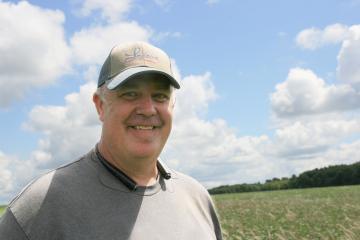
Greg Entinger in rural New Prague was a farmer with an erosion problem. Today he is a proponent of strip tillage, cover crops, intake treatments, sediment retention areas, nutrient management, and other practices that build soil health and reduce erosion. By keeping more soil on the land and holding more water, these practices also help water quality downstream. Wanting to show other farmers that conservation can pay economically as well as environmentally, Entinger decided to enroll in the Minnesota Ag Water Quality Certification Program through the Department of Agriculture.
Entinger grows corn and soybeans on 925 acres in Le Sueur and Rice counties that drain to Sand Creek and then the Minnesota River. The Minnesota Pollution Control Agency (MPCA) recently released several studies on the Minnesota River Basin that call for widespread changes, especially on cropland, to improve the water quality of the river and its tributaries.
Entinger uses several best management practices (BMPs) that help water quality. However, water quality wasn’t his main reason for changing his cropping system. "The strip tillage because I had erosion … in 2013, we had so much erosion. I decided to make a change," Entinger says. "With an engineering background, I thought ‘What can I bring to the farm?’ ”
After doing extensive online research, attending many farm shows, as far way as Louisville and Des Moines, and consulting with other farmers, he decided to switch to strip tillage in 2015. His investment paid off. Since then, he has seen a bump in yields and a decrease in costs, meaning more profit per acre. The cover crops soon followed. While expensive to plant, cover crops build soil health and lead to reduced fertilizer use.
Aug. 28 events: Entinger farm field day; Lower Minnesota River boat tour
MPCA Commissioner Laura Bishop will present Greg Entinger with his water quality certification on Aug. 28 at his farm. The program will start with lunch at 12:30 p.m. and include a showcase of his practices. Those planning to attend should RSVP to Cathy Rofshus at the MPCA by Aug. 23.
The Minnesota Pollution Control Agency, Savage Chamber of Commerce and the Lower Minnesota River Watershed District invite you to a boat tour of the Minnesota River, Aug. 28 at the CHS terminal, 6200 West Highway 13, in Savage. Boarding begins at 3:30 p.m. with planned departure at 4 p.m. It will land and disembark at Harriet Island in St. Paul around 7 p.m. Buses will return passengers to Savage.
Box lunches will be provided and a cash bar will be available. Please advise of any dietary restrictions when sending your R.S.V.P. Registration is required to the Savage Chamber at mail@savagechamber.com.
|
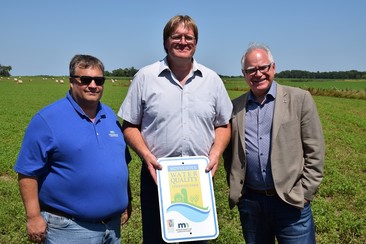
More than 500,000 acres of Minnesota farmland are now enrolled in the Minnesota Agricultural Water Quality Certification Program (MAWQCP). MASWCD celebrated this milestone on Aug. 1 with farmers and partners at Jon and Carin Stevens’ Maple Grove Farm in Pine County. Photo: L-R: Dept. of Agriculture Commissioner Thom Petersen, Jon Stevens, Gov. Tim Walz.
The MAWQCP is a voluntary program for farmers and landowners to implement conservation practices that protect Minnesota’s waters. To date, more than 772 farms and 500,000 acres have been certified.
Minnesota Agricultural Water Quality certified farms have added 1,557 new conservation practices, including over 52,000 acres of new cover crops, that protect Minnesota’s waters. Those new practices have kept over 34,000 tons of sediment out of Minnesota rivers while saving nearly 86,000 tons of soil and 41,000 pounds of phosphorous on farms each year. The conservation practices have also reduced nitrogen loss up to 49% and cut greenhouse gas emissions by more than 30,000 tons per year.
|
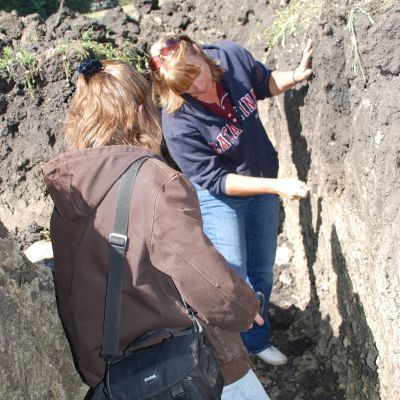
Farmers and agronomists are invited to this unique, small-group field day "in the pits" Sept. 10 to learn about soil health. Participants will see how soil responds to different tillage, topography and crop management practices by examining the soil profiles in four different pits. Learn about:
- How to identify different levels of soil structure.
- How to sample soil and determine soil texture.
- How to relate soil analysis results to soil type and depth, slope, and management (organic matter, pH, phosphorus, potassium, salts and carbonates).
- Why aggregated soils are beneficial.
- How to avoid or remedy soil compaction.
- What microbes and earthworms need to thrive.
Tuesday, Sept. 10, 9 a.m.-3 p.m., American Legion, 60 6th Ave., Granite Falls. For more information contact: Mary Jo Fox, foxxx055@umn.edu or 320-235-0726 x2001. There is no charge, space is limited. This event is co-sponsored by University of Minnesota Extension, SWCD and the Hawk Creek Watershed. Register online.
|
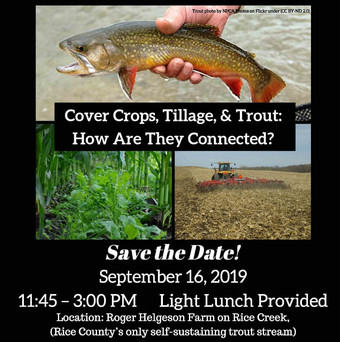
Fishers and farmers will team up on a field day Sept. 16 at the Roger Helgeson farm on Rice Creek, 9821 Decker Ave., Northfield. Organized by Al Kraus-Cannon River Watershed Partnership and Rice County SWCD, the field day will explore the watershed connections between agriculture, conservation, water quality, and habitat. There will be a farmer panel on cover crops and conservation tillage, electro fishing demonstration and habitat discussion, stream table, and aquatic insect demonstration.
Since 2009 Minnesota has been represented on the Fishers and Farmers Partnership steering committee by Steve Sodeman and Jack Lauer. Steve is a farmer, crop consultant, and former Minnesota Corn Growers Association director; Jack is DNR Southern Regional Fisheries Manager in New UIm. Fishers & Farmers has helped fund several projects in Minnesota over the past 10 years, such as 7-Mile Creek, Rice Creek, Rush-Pine, Whitewater, and Root River.
"Fishers and Farmers puts landowners in the lead for better farms and fish habitat," says Heidi Keuler of the U.S. Fish and Wildlife Service office in La Crosse. "I'm excited to see the energy from farmers in Minnesota and I hope Fishers and Farmers Partnership can keep adding to it. Our steering committee members tell me over and over again that they can accomplish so much more together than they can individually in their own organizations."
Last fall, eight farmers planted cover crops on about 800 acres of land in the Rice Creek watershed just west of Dundas in southeast Minnesota. In 7-Mile Creek, a tributary of the Minnesota River north of Mankato, they have worked with farmers to complete 65 conservation best management practices, and planted more than 100 marginal acres to perennial vegetation. Several farmers are incorporating conservation drainage, strip and no till, and cover crops. It also helps support the LeSueur River Watershed Network.
|
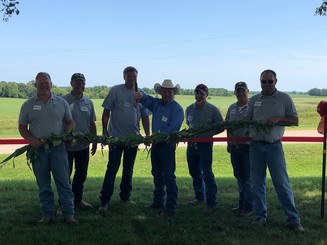
A ribbon-cutting launched the partnership between the Minnesota Soil Health Coalition and Minnesota Natural Resources Conservation Service Aug. 16 during the Soil Health Academy at the Grant and Dawn Breitkreutz' Stoney Creek Farm west of Redwood Falls. About 200 farmers and agency staff attended, learning all aspects of regenerative farming and ranching, soil health, plant health, and animal health from well-known experts such as Ray Archuleta and Gabe Brown (see video).
Facebook page notes: Speakers included Thom Petersen, Brad Redlin, Theresa Keaveny, and Anna Cates prior to the ribbon cutting ceremony commemorating the partnership between the Minnesota Natural Resources Conservation Service and the Minnesota Soil Health Coalition with Troy Daniell completing the cutting. Gabe Brown and Ray Archuleta from Understanding Ag, LLC provided background prior to stations: Rainfall simulator with Ray Archuleta and Holly Kesteloot Hatlewick, wind erosion simulator with Brian Pfarr and Shannon Gegner, soil pit with Kristin Brennan and Brandon DeFoe, and cover crop plots.
|
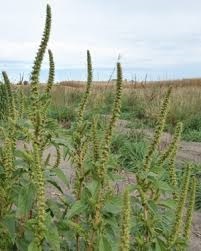
The Department of Agriculture is looking for help in tracking down Palmer amaranth, an invasive weed that has the potential to do great damage in Minnesota and cost the state’s farmers millions of dollars. If Palmer amaranth were become established in the state, it would cause substantial yield losses and greatly increase weed management costs in soybeans and corn.
It was first found in Minnesota in 2016 in conservation plantings. Since then the MDA has identified it in several row crop fields. Palmer amaranth got into those fields through manure. It’s been determined that animals had been fed screenings containing the weed seed. Livestock produders can help reduce the risk of Palmer amaranth and other noxious weeds entering Minnesota by filling out a voluntary survey.
Screenings are the byproducts of seed processing and are obtained through the cleaning of grains. Screenings are commonly sold and used as animal feed, roughage, and bedding and can consist of many kinds of grain byproducts. Types of screenings that are used may include:
- Grain screenings: contain 70% or more grains (corn, barley, oats, rice, sorghum, wheat).
- Cereals and mixed grain screenings.
- Chaff and/or dust screenings: material that is separated from grain or seeds during the cleaning process, and may include hulls, joints, straw, dust, sweeping, sand, dirt, grain, and seeds.
For more information about Palmer amaranth or this survey, contact the Mike Merriman at michael.merriman@state.mn.us or 651-201-6386.
|
The Department of Agriculture is seeking a Nitrogen Fertilizer Management Plan coordinator. This lead position will be responsible for managing the development, implementation and evaluation of Minnesota’s Nitrogen Fertilizer Management plan (NFMP), which directs the response to preventing and mitigating high levels of nitrate in groundwater from inorganic fertilizer sources. For more information contact Larry Gunderson at larry.gunderson@state.mn.us or 651-201-6168. If you have questions about applying for jobs, contact the job information line at 651-259-3637. For additional information about the application process, go to http://www.mn.gov/careers. The application deadline is Sept. 12.

The Minnesota Board of Animal Health encourages livestock owners to make sure their animals are healthy, and their livestock equipment is cleaned before departing to exhibit at the Minnesota State Fair this year. Each August, the State Fair hosts more than 20,000 animals participating in livestock competitions, shows and exhibits.
No animal may enter, or be present at, a public exhibition if it is showing clinical signs of any infectious, contagious or communicable disease, including ringworm and warts. Official veterinarians will be inspecting all livestock on the day they are admitted and daily during the fair. Any animals showing signs of illness must be removed from the fair at the direction of an official veterinarian. For more information, download the Board’s simple biosecurity checklist to use before, during and after exhibiting.
|
Calculating the value of cover crops, No Till Farmer, 8/2/19
‘Learn, unlearn and relearn’: Farmers benefit from soil health practices, AgriNews, 8/6/19
Challenges in karst country farming, AgriNews, 8/1/19
Aug. 28: Entinger farm field day; Minnesota River tour-see above article.
Sept. 10: Life in the pits-soil health workshop, American Legion, Granite Falls.
Sept. 16: Fishers and Farmers field day, Rice County SWCD, Roger Helgeson farm, 9821 Decker Ave., Northfield.
Dec. 8-10: Minnesota Association of Soil and Water Conservation Districts, Doubletree, Bloomington.
Dec. 17-18: Conservation Tillage Conference, St. Cloud.
The
MPCA Feedlot Update welcomes news from partners about, projects, people, and
upcoming events. Email submissions to forrest.peterson@state.mn.us.
Past issues of Feedlot Update are available on the feedlot program publications webpage.
|